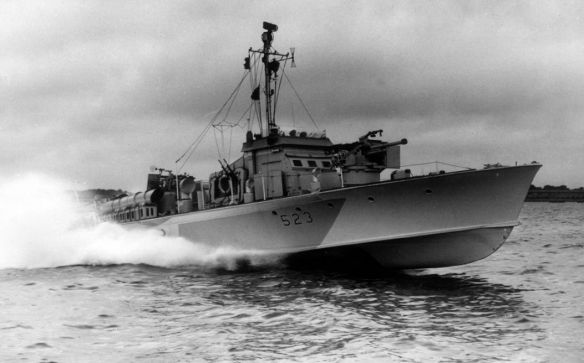The prototype of the Vosper Type II MTB 523 runs trials in July 1945. Effectively dual-purpose MTB/MGBs, this class mounted the powerful 6pdr forward and a twin 20mm aft, with the torpedo armament reduced to two 18in tubes. At the masthead is Type 268U radar and the lattice twin cones on the short forward-projecting spar is a Type 253 IFF transponder.
The ultimate wartime development of the Vosper design, the Type II combined the roles of MTB and MGB, with a 6pdr 7cwt Mk IIA gun on the Mk VII power mounting forward, twin 20mm Oerlikon MkXII mounting aft, two twin 0.303in Vickers GO machine guns, and two 18in LC Mk II torpedo tubes. Uprated Packard engines still produced enough power for a near-40kt maximum speed, or 38kts continuous.
The Type II Vospers were all completed too late to see war service. The last of them, MTB 538 shown here, was built to a new hull design and was not finished until 1948. They were designed for quick changes of armament according to whether the function required was more MTB or MGB.
By this period in the war MTBs to Vosper designs and the 71ft 6in Motor Gun Boats built by the rival British Power Boat Company were at the height of their wartime development. Just as MTBs were now expected to operate as gunboats, it was realised that the MGBs would also be capable of performing a dual role if they were modified to carry two 18in torpedo tubes. This meant that they would be included in the MTB numbering scheme from September 1943, and this renumbering was introduced as the modifications to the MGBs were completed. For reasons of space, these units both as MGBs and MTBs do not figure in this volume.
Twenty more MTBs were ordered in December 1943. The first four numbers 519–522 went to modified MGBs (now renumbered as MTBs) ordered from the British Power Boat Company, but numbers 523–538 were to be of the 73ft Type II or 1944 Vosper Programme, Contract CP 8E/112282/43. Based upon the hull from the previous group, the design had again been tweaked in the light of current practice. The armament was again upgraded, the previous twin 20mm mounting being replaced by the heavier but much more potent 6pdr 7cwt Mk IIA gun on the power-operated Mk VII mounting with a Moulins auto-loader. This had begun life as an antitank gun, but was also used in some marks of the Mosquito fighter-bomber for attacking U-boats. The twin 20mm mounting was relocated aft and the torpedo armament was reduced to the after pair of tubes to balance the load on the hull. The 6pdr gun now carried the Rocket Flare Launcher (if fitted) and the bridge had many more state of the art electronics. The speed was almost 40kts at 2500 rpm or 38kts at 2000rpm with a range of 480 miles at 20kts. By this time the construction of the upper deck had been made easier by using 58in thick marine ply sheets rather than the early double diagonal mahogany planking.
The bridge too was more functional with a place for everything and everything in its place – a steering compass and a navigational compass, boost gauges, engine revolution counters, voice pipes, a bullet-proof rear door, loud hailers, torpedo sights, and built-in flag lockers, with a helm now more like a steering wheel on a car. This was the last wartime variant of the standard Vosper design that could trace its ancestry directly to the PV project of 1937.
